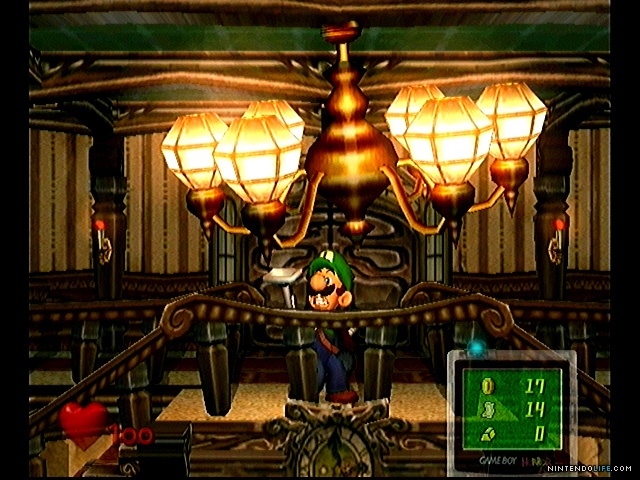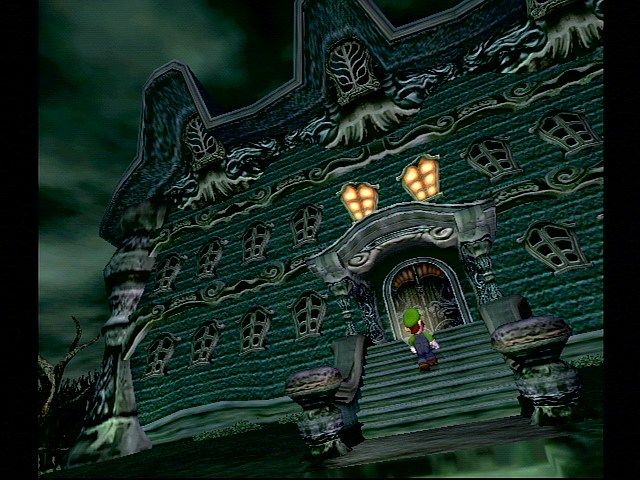Retro Review: Luigi’s Mansion (2001)
Welcome to the Retro Review section, where Ben reviews older games and looks at how they’ve held up.

The first thing you’ll notice about Luigi’s Mansion is that it’s missing Mario. That seems obvious when you consider the title of the game, right? Only, Nintendo placed the ghost-busting Luigi game right in the thick of its launch lineup for the Nintendo Gamecube, which, coincidentally, was missing a Mario game.
Immediately, you see Nintendo (and director Hideki Konno) try and steer expectations. Not only is this not a Mario game, it doesn’t even bother to play like one. Instead, you’re left with a handful of familiar side characters (Boo, Luigi and Toad) in what will certainly feel like some kind of comedic spin-off. Luigi is given a vacuum for a weapon (the “Poltergust 3000”) and a flashlight. Even the the early-game plot mechanics are kind of hilarious, as Luigi mistakenly believes he has won a free mansion via a giveaway. Cue the laugh track.
Fortunately, once you look past the game’s obvious attempt to separate itself, it’s actually really fun and intuitive. The basic mechanic behind the game functions the same way that Boo has always frightened Mario in the past: Shine a light from afar on an enemy ghost (which are rarely actual “Boo’s”, but rather more generic looking ghosts) and it disappears. Shine it when it’s really up-close and personal and you freeze it. Once you’ve done that, you use your vacuum to suck ’em right up.
The mechanics rarely get more complicated than that, but each ghost (including a set of fun bosses) have their own unique kick to them. Whether that be a ghost that stuffs itself with (dead?) food and then throws it at you or a set of spooky twins who try and run you over in their play vehicles, there’s a decent amount of variety in the kind of enemies you’ll see. Generally speaking, to even get the chance to fight these bosses, you’ll also have to solve a puzzle or find a hidden location to trigger a chance to beat them.
The puzzles and hidden pieces of the game feel very much like a point and click adventure. More often than not, the player will enter a new room, spot a “boss” ghost and be unable to fight against it. In order to do so, you must first find a way to make them vulnerable. Each boss has a unique trigger event, whether it be opening up a window to the chilled outdoors or tossing a bone to a long-dead dog. Sometimes the events feel contrived while others result in a well-deserved feeling of triumph. Exploring the haunted mansion is Luigi’s Mansion‘s best bit of design, especially when you consider how interconnected everything is.
Many times, the reward for emptying a new room in the mansion is a key, which, inadvertently, unlocks a new room. More like a Zelda dungeon than anything out of a Mario game (aside from, say, Mario 64), the reward for exploration and success is more opportunity for exploration and success. Every now and again, this success leads to a shortcut being unlocked or even a new weapon tool – in the forms of ice, water and fire. It isn’t much, and the game certainly doesn’t avoid redundancies, but every new room is just different enough that it’s hard not to creek open a new door and see what awaits you next.
Released in 2001, Luigi’s Mansion isn’t exactly an antique. It certainly stands the test of time, especially if you’re able to play on a functional Gamecub controller. The trigger buttons enhance an already immersive experience, as clicking the flashlight and Poltergust 3000 on and off is extremely satisfactory – almost as if you were utilizing the weapons yourself. The visuals are muddy and textured, but the art style stands alone as being one of the few sullen-looking Nintendo games to date. Konno and crew go above and beyond in terms of attention to detail, as library rooms are packed full of books and crackling fireplaces, and weightrooms filled with dumbbells and other workout equipment. It’s an ascetically unique title, and worth playing for that alone.

The game extends only a single card of replay ability to its players, in the form of collecting money for a (hopefully enhanced) new mansion by the end of the game. You’re graded by fellow ghost-enthusiast Dr. E. Gadd, who takes your money and builds you something new. The time spent with your new mansion is very small, leaving little reason to believe that it wasn’t simply a throw-in on Nintendo’s part. The game only runs a half–dozen or so hours long, so this might be a sticking point for any gamers thinking about picking the game up – especially when you consider its hefty price tag. Unfortunately, Gamecube games remain unavailable on all forms of Nintendo’s Virtual Console.
Ultimately, Luigi’s Mansion shines because of how separated it is from Nintendo’s main line of colorful first-party titles. It’s comedic, spooky in the most light-hearted way possible and a unique glimpse into the oft-forgotten sidekick, Luigi. At the very least, it’s one of the best uses of the wonky Gamecube controller in the console’s history.
Score: 7.5
Rank: 61
Virtual Console: No
Worth the Price: No
